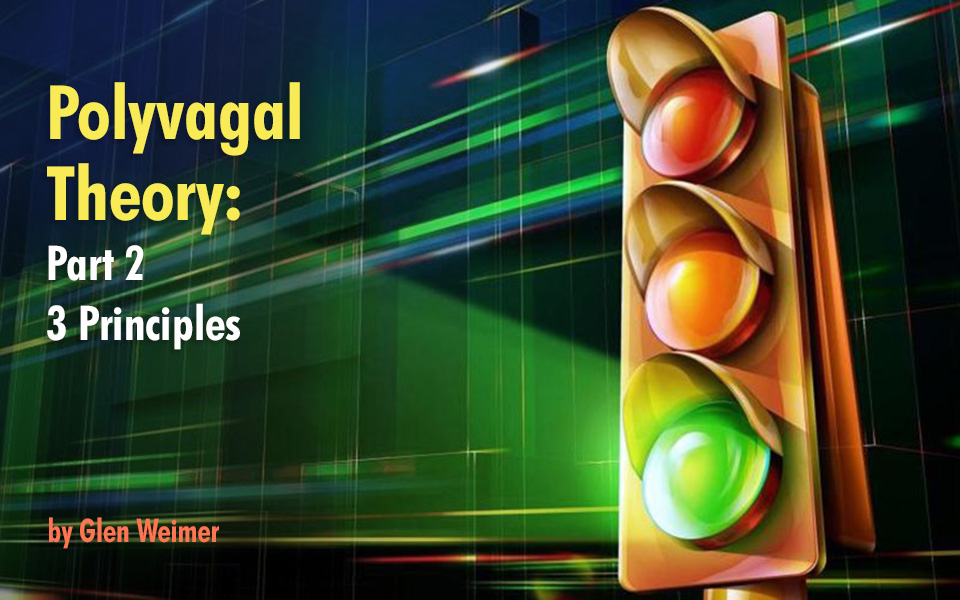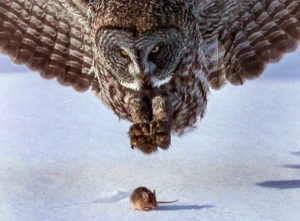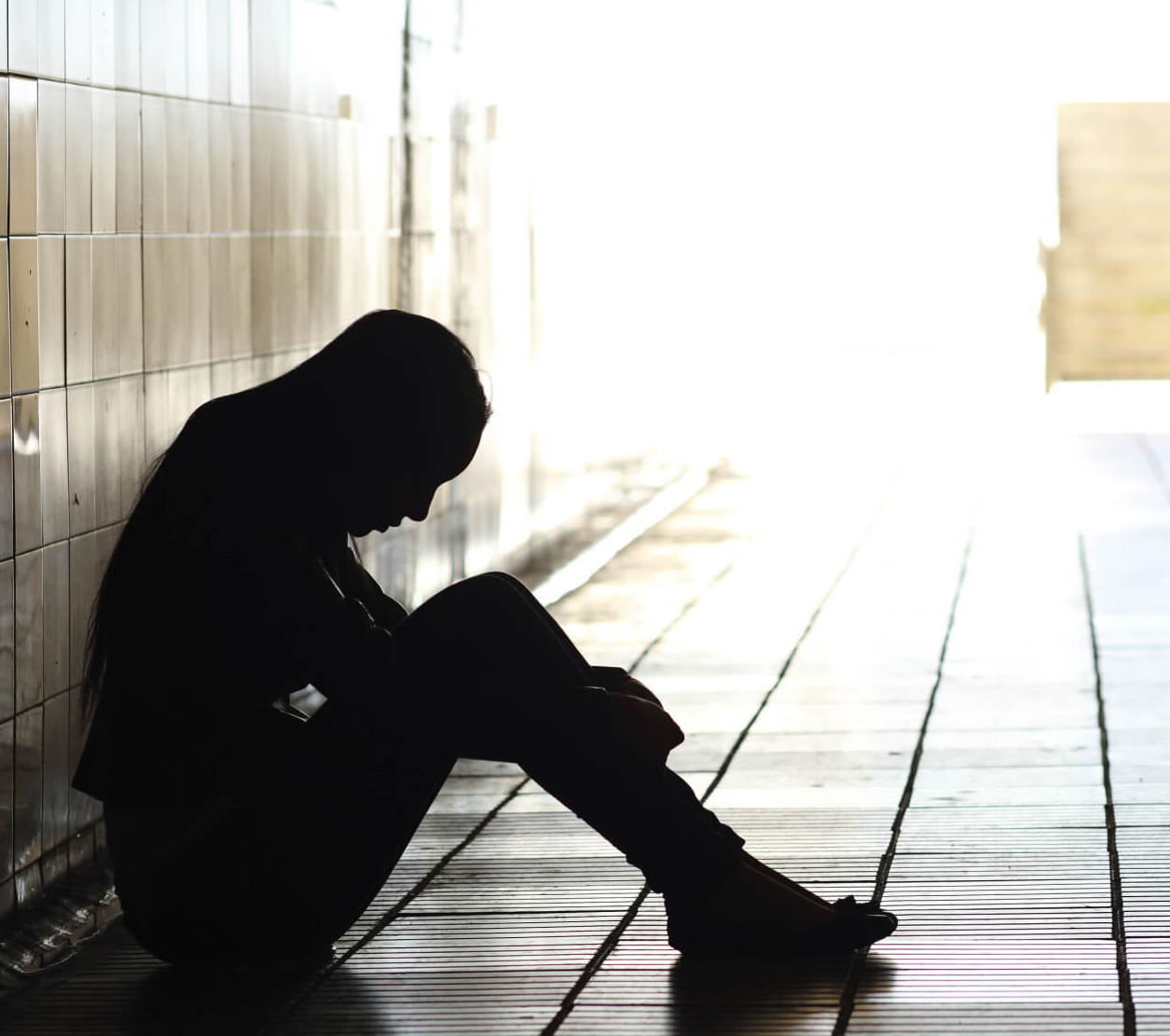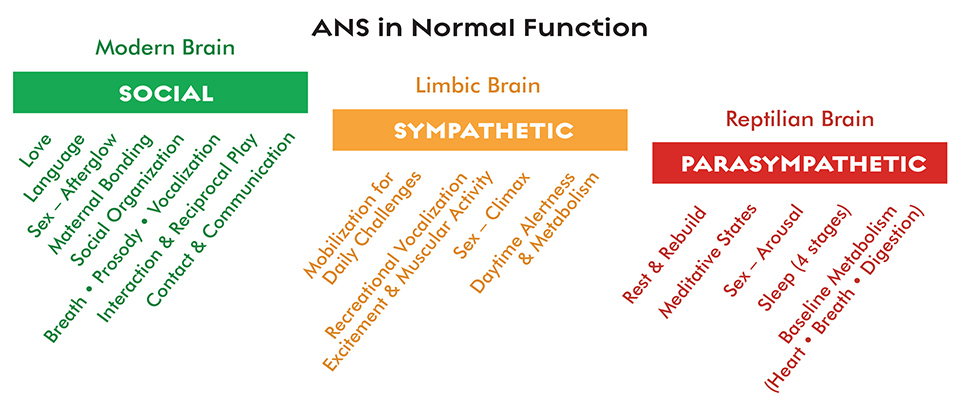Please note: this is the second of a 5-part blog. (see Part 1)
Neuroscientists estimate that 95 percent of brain activity is beyond our conscious awareness, as if we are going through life on autopilot. Polyvagal Theory provides the tools to understand the actual mechanism controlling this subconscious autopilot and empowers us to take control of our thoughts and actions, which ultimately completely changes both how we perceive life and how the world responds to us.
3 Principles of Polyvagal Theory
Polyvagal Theory has three organizing principles. Here in Part 2, we’ll take a closer look at these: Neuroception scans the environment then mobilizes the Autonomic Nervous System to respond which we Co-regulate through our our relationships with others.
- Neuroception
- 3-Tier Autonomic Nervous System
- Co-regulation
 Neuroception
Neuroception
Neuroception is a term Dr. Stephen Porges coined to describe the mechanism our nervous system engages to evaluate our level of safety or threat. Different from perception, this occurs far below our conscious thoughts, similar to a home security system. It then mobilizes all body functions necessary to meet that challenge. Author Deb Dana says, “before the brain understands and makes meaning of an experience, the autonomic nervous system, via the process of Neuroception, has assessed the situation and initiated a response.”
Neuroception analyzes everything we see, smell, hear and feel. It compares this current data to previous experiences of potential danger and engages a full-body response all before we are aware of any conscious impressions. When we meet a person we often unknowingly scan their face, voice and subtle gestures to determine how we should respond—are they friend or foe?
Additionally, we might walk down an empty supermarket aisle and suddenly find our heart racing and palms sweating. With no obvious threat, our Fight or Flight response was triggered by a subconscious association made between a red cereal box and the red from a traumatic childhood memory; or perhaps the music playing in the store is the song which was on the radio when our spouse unexpectedly declared they were leaving.
Autonomic Nervous System
Our Autonomic Nervous System (ANS) regulates all the automatic body functions that we do not have to think about: heart rate, breathing, digestion, etc. In fact, every organ, system and function of the body is coordinated by this communication between brain and body. Like a subroutine running in the background of our core operating system which controls absolutely EVERYTHING (usually below conscious awareness), it enables us to survive in times of threat and empowers us to thrive in times of safety.
The ANS’s primary function is to keep us alive—it manages risk and up- or down-regulates different body functions in response to our perceptions of safety or threat. Historically, this was thought of as a binary system similar to flipping a switch: Sympathetic (Fight or Flight) and Parasympathetic (Rest & Rebuild).
Dr. Stephen Porges expressed a more nuanced and meaningful model as a hierarchy with three levels. These levels correspond to our evolutionary development as a species from reptile to primitive mammal to human/modern mammal. Three neural pathways form this evolutionarily ordered hierarchy that regulates behavioral and physiological adaptation to Safe, Dangerous and Life-threatening environments, and is illustrated below by the traffic light graphic.
Porges likens it to playing cards; when we engage with others we play our modern, best card first (Ventral Vegal / Social Nervous System); engaging with eye contact, smile and warm greeting. Neurologically we are reaching out to connect. If not well received we play our older, second card (Sympathetic/Fight or Flight). When all else fails we play our final card (Dorsal Vagal Parasympathetic/Freeze-Collapse).
A high percentage of health conditions center on the autonomic nervous system’s ability to regulate; including but not limited to autoimmune disorders, attention deficit conditions, psychosomatic issues, and post-traumatic stress effects.

GREEN LIGHT • Social
Our most modern response, and the one which distinguishes humans and modern mammals, is our ability, at least in theory, to be in proximity to one another without attacking or responding to everything as a threat. This is the Ventral Vagal branch (VVC) or our Social Nervous System. This state requires a perception of safety which enables us to connect and bond with others and to ultimately thrive in our world. In Ventral Vagal our brains produce Oxytocin, sometimes known as the cuddle or love hormone, which engages brain areas involved in processing our socializing, bonding, pleasure, and reward systems.
In this state, our energy and blood flow is in our unconscious facial and vocal expressiveness, and our heart and chest. From a Polarity Therapy perspective I think of VVC as our ‘Neutral’; feeling safe in the world and with others enables social interaction (outward engagement) or settling into meditative (inward-oriented) states. From this neutral, we can further upregulate to Sympathetic mobilization or downregulate to Dorsal Vagal (DVC) immobilization.
Safety, both enables us to engage with our outer world and also, knowing that our body is safe, allows us to go deep into altered states. I think of the VVC as the doorway to mediation and higher states of consciousness.
When co-regulated with DVC our breathing and heart rate are slow and measured and we are primed for tissue repair and recovery. Our digestive system is engaged in breakdown, assimilation and elimination. And we suppress adrenaline and stress hormones and engage higher cortical brain activity such as cognition, attention and memory.
ORANGE LIGHT • Danger
If we feel threatened in any way, this state engages the more primitive part of our mammalian brain: the Fight or Flight response of the Sympathetic Nervous System (SNS); activating the body to fight or run away from the perceived threat. Another way of sayng that is our Confrontation or Avoidance response. Designed by evolution to mobilize us into immediate action, it down-regulates all non-essential body functions such as the digestive and reproductive systems. And diverts the blood flow out to the big muscle groups in the neck and shoulders to fight, and to the low back, butt and legs to take flight.
This is meant to be an instant response to an imminent threat. Unfortunately, we are using the same response that served us well in the jungle to meet our modern world challenges. The problem is that we often don’t feel like we can act, so the SNS is continuously engaged in a frustrated Flight or Flight pattern. The body holds a standing tension in the upper body when social, moral, ethical constraints keep us from fighting back because it’s our boss, a client or family member. We hold on to the flight response in our low back, psoas, butt and leg tension when we can’t run away from our problems.
RED LIGHT • Freeze / Collapse
If our nervous system determines that there are no good options to avoid the threat we engage the Dorsal Vagal branch of our Parasympathetic Nervous System (DVC) or freeze-collapse response. This is the most primitive part of our reptilian brain. In this state we believe death is imminent and therefore numb and dissociate from our body as we surrender to complete overwhelm.
For many of us this became a learned response from early childhood and is our default response to stress. Whenever we feel stimulated, stressed and anxious, rather than mobilizing we collapse. This can often lead to self-medicating, dissociating or sleeping to avoid the awful feelings. We may feel as if we are barely alive.
This state makes the process of addiction recovery so difficult. As soon as we return to a ‘normal’ state of consciousness or start running more energy through our bodies to reengage with life, we begin to feel that nervous activation and the return of those intense, unpleasant feelings so we fall back into our addiction/avoidance behavior.
“We live a story that originates in our autonomic state,
is sent through autonomic pathways from the body to the brain,
and is then translated by the brain into the beliefs that guide our daily living.
The mind narrates what the nervous system knows. Story follows state.”
Deb Dana, The Polyvagal Theory in Therapy
Co-regulation
Polyvagal Theory identifies Co-regulation as a biological imperative: a need that must be met to sustain life. We regulate our ANS together with others through our relationships. Others can agitate and activate us, but conversely through co-regulating we can feel safe enough to move into connection and create trusting relationships which enables us to thrive physiologically and in our lives. Practiced co-regulation gradually enables us to self-regulate.
All three ANS states are self-reinforcing, in that we perceive our world as being identical to the state we are in. When we feel safe we experience a nurturing and supportive world, when threatened we see danger everywhere. Healthy, loving relationships enable us to get close to others, and form bonds of friendship and love. Without this, our perception of a dangerous world forces us to keep everyone and everything at a safe distance. Likewise, physiologically, our bodies are either in growth, nourishment, thriving mode or in protection mode where nutrients are ‘blocked’ from entering the tissues and the BMS functions as isolated, uncoordinated parts.
It is not an exaggeration to say that without love we wither and die. It’s precisely this that happens to new borns deprived of physical contact and bonding. Our webwork of interconnections empowers us to meet life’s challenges (see my Resourcing blog).
Continue reading. Go to Polyvagal Theory – Part 3
Polyvagal Theory Resources:
- Dana, Deb A., Anchored: How to Befriend Your Nervous System Using Polyvagal Theory (2022)
- Dana, Deb A., The Polyvagal Theory in Therapy: Engaging the Rhythm of Regulation (2018)
- Porges, Stephen W., The Pocket Guide to the Polyvagal Theory: The Transformative Power of Feeling Safe (2017)
- Rosenberg, Stanley, Accessing the Healing Power of the Vagus Nerve: Self-help Exercises for Anxiety, Depression, Trauma and Autism (2017)
- Also go to blogs Resourcing: Meeting Life’s Challenges
- Overwhelm: The Root Cause of All Disease – Parts 1 to 4
- Trauma & Bodywork Thesis
- Body-Mind-Spirit 1: Consciousness
Disclaimer:
The information featured on this site is provided for information and education purposes only and is not intended to replace the advice of your doctor or health care provider on medical and/or health-related issues.
You should not use the information on this site for diagnosis or treatment of any health problem or as a substitute for medication or other treatment prescribed by your physician or health care provider.
Submit your review | |




